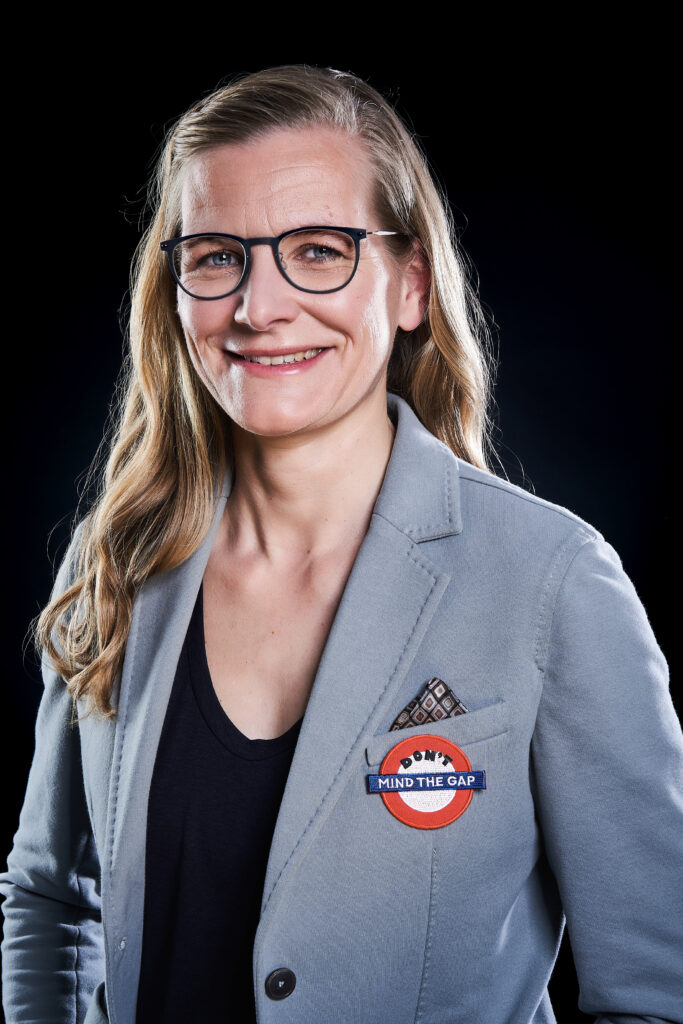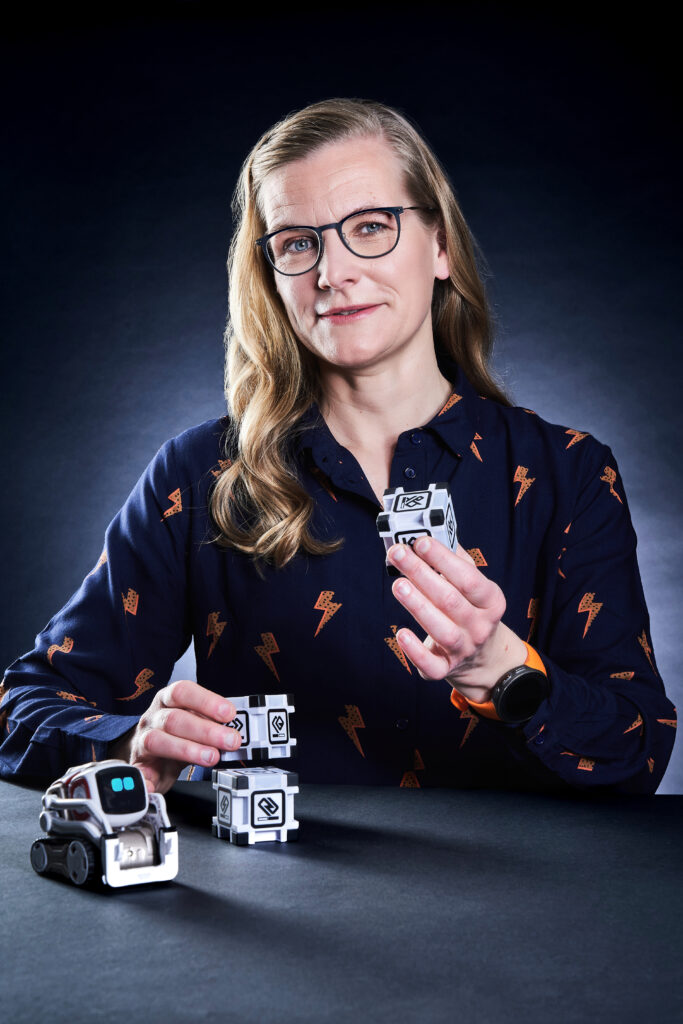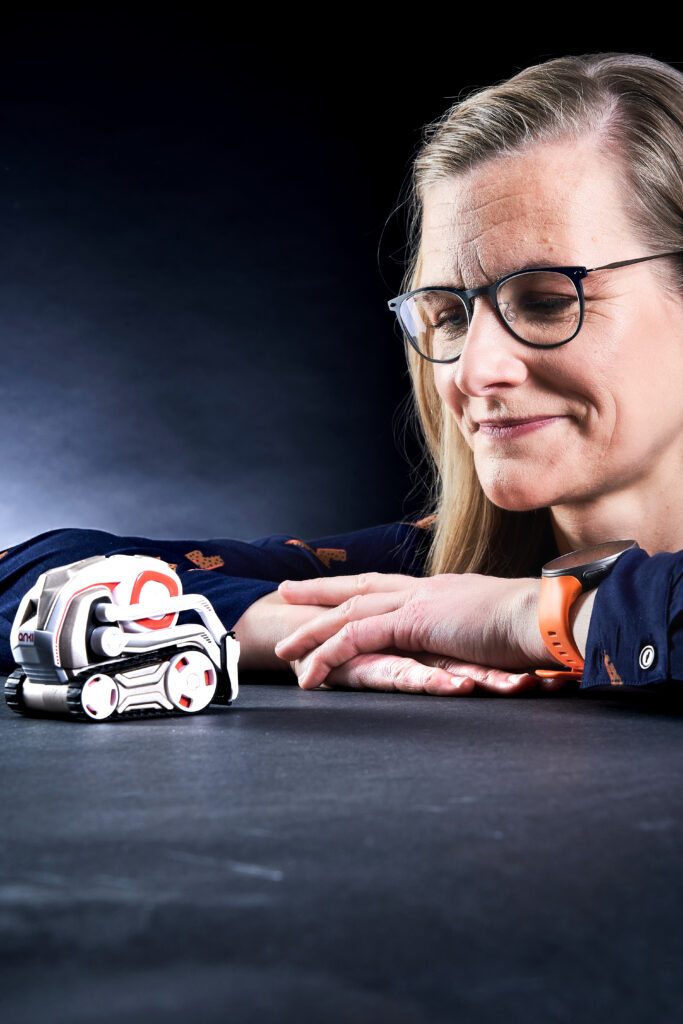Robots at half distance – a portrait of Sabrina Livanec

I meet Sabrina Livanec at her workplace, in the „Intelligent Machine-Brain Interfacing Technology“ (IMBIT) building, the headquarters of the BrainLinks-BrainTools center. IMBIT is located on the Flugplatz campus, which is primarily used by the Technical Faculty. The world of the Technical Faculty and IMBIT seems to be full of innovation and progress – the buildings are new and chic, everything has its place.
My conversation with Sabrina is similar to her work – we don’t sit down in one place and stay there, together we explore the different spaces and the various activities that Sabrina pursues. She takes me to the NEXUS Lab first, one of the central locations of her work. It is named after NEXUS Experiments, a platform for participatory science education and community-based participatory research located at BrainLinks-BrainTools.
Sabrina manages NEXUS together with Phillipp Kellmeyer. Thematically, the platform covers the areas of neurotechnology, artificial intelligence, robotics and human-technology-interaction in general. The walls of the NEXUS Lab are covered in pictures of past projects, which Sabrina tells me about.
For example, there are photos of the BMBF-funded project „Urban Wall Research: Artificial Intelligence and Street Art“, in which large-format murals were designed by artists and scientists in a co-creative process on buildings in the Freiburg city area, i.e., in public spaces. Sabrina explains that the roots of the platform lie in such formats at the interface of science, society and art and that they continue to be an important part of her work. Last July, for example, NEXUS organized the two-day „Data Wonderland“ festival, where visitors were able to explore the use of health data in a playful and creative way. In the future, however, NEXUS will increasingly focus on citizen science and, above all, on community-based participatory research.
The aim is to bring different stakeholder groups – researchers, developers, designers and, of course, citizens – into conversation within the framework of mini real-world laboratories. The main focus here is on the exchange between scientists and non-scientists. Ideally, both sides could learn a lot from each other, says Sabrina. This gives people who may not have many contact points with technology or science the opportunity to engage with such topics in a low-threshold way. At the same time, researchers benefit from being able to better understand the views, concerns and problems of potential end users.
After the NEXUS Lab, we enter the adjacent robot hall, which is related to Sabrina’s second field of activity. In addition to managing the NEXUS Experiments project, she is also working on a doctorate in psychology. Even though she is looking at the topics from a different perspective, the work for her doctorate is very closely linked to the NEXUS projects. „In Andrea Kiesel’s working group, I have the opportunity to work on the development of a new method, namely cognitive-affective mapping. This can be used very well in the context of community-based research and it can help us investigate, for example, which characteristics certain technologies, such as social robots, must have in order to be accepted and used by different stakeholder groups.“
Sabrina originally has a background in humanities and economics. Sabrina considers this “half-distance” point of view as an advantage when it comes to developing innovative and experimental approaches to communicating these topics. She certainly radiates the curiosity required for this. Sometimes she and her colleagues have to explain why their work is actually important. But despite all the hurdles that this transdisciplinary work entails, Sabrina’s great enthusiasm is clear to see. She particularly appreciates the freedom to implement ideas that seem off the beaten track at first glance – such as the realization of the NeuroOpera, a joint project of the Community Opera Freiburg and researchers from BrainLinks-BrainTools.
Sabrina tells me a lot about her work, shows me specifically which projects were part of NEXUS Experiments and what the experimental setup for her research in psychology looks like. This is less about her as a person – the work speaks for itself. As we leave the robot hall and Sabrina shows me other areas of IMBIT, she also tells me that she hardly uses social media in her private life or has any other type of digital presence. As such, it’s not surprising that I didn’t find much about her beforehand; it seems to me that she prefers for her work to tell her story.
She is similarly reserved when it comes to questions about being a woman in science. „To be honest, the phrase ‚being a woman in science‘ creeps me out a little,“ she explains with a smile and continues: „I don’t really want it to play any role and therefore don’t think it’s worth mentioning that I’m a woman.” At the same time, she is very aware that it often does play a role. „A lot is happening in the area of equality, but there is still a long way to go.“ Of course she is constantly made aware that she is a woman, for example when she is asked why she works full-time – which happens regularly, although not necessarily in the context of university. After all, she is the mother of two children. „That’s exactly why!“ she would like to reply sometimes. „Even if it’s not easy sometimes, I keep going. I like my work and I think it’s important to teach my daughter that there are basically no limits to what she can do. But perhaps,“ she adds, „this realization is even more important for our son.“


Portrait by Clara Kisser
Clara Kisser studies Liberal Arts and Sciences with a major in Governance at the University College Freiburg. She is particularly interested in feminist philosophy, political theory, and the influence of technology on society and democracy. She would like to continue studying forever to deepen these interrests even more – even though her Bachelor’s thesis really is due next semester. In her free time, she likes to draw and paint while watching British crime thrillers.